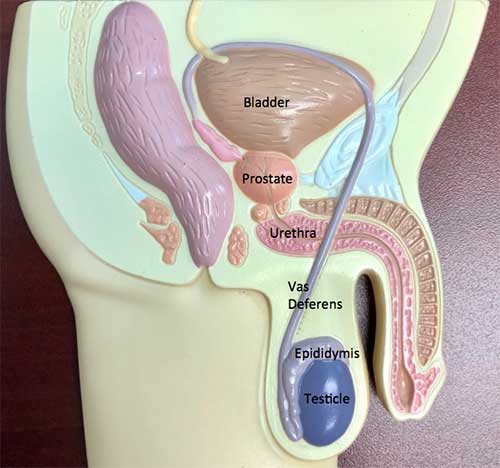Hydrocele
Hydrocele is a term used to describe a dilated sac of fluid which forms around the testicle. The male anatomy is shown in the picture.
The scrotum, or sac, contains a testicle on each side. The testicle has two functions. It makes testosterone, the male hormone, which is absorbed into the blood stream. It also makes sperm which travels from the testicle into a series of tubes which collectively form the epididymis. The epididymis sits to the side and in back of the testis. Sperm leaves the epididymis by way of the vas deferens (this is the tube that is divided during a vasectomy) which travels to join the seminal vesicles and prostate. Sperm mixes with fluid from the seminal vesicles and prostate to produce semen, the fluid that comes out from the penis at the time of ejaculation.

Normally there is a thin sac of fluid which surrounds the testicle. When this sac becomes distended with fluid, a hydrocele forms.
Causes of a Hydrocele
One of the causes of hydrocele formation is an open communication in the spermatic cord between the hydrocele sac and fluid in the abdominal cavity. This type of hydrocele, called a “communicating hydrocele” is the most common type in children and adolescents. If left untreated, a hernia may develop. Other causes of hydroceles can include infection, trauma and even rarely a tumor of the testes. In most cases, no underlying cause can be identified.
A physician can detect a hydrocele on physical examination. Occasionally a scrotal ultrasound may be recommended.
Treatment of a Hydrocele
There are several ways to treat a hydrocele. When a communicating hydrocele is present, it should be fixed through surgery using an incision in the inguinal area. For other hydroceles, treatment depends on size. Small hydroceles can be left alone. They may be present for years and never cause any trouble. For larger hydroceles, ones that increase in size over time or ones that cause symptoms (such as pain, ache, “dragging” sensation and so on) surgical intervention is recommended.
In most cases, surgery is done on an outpatient basis. An incision is made in the scrotal wall, the fluid is drained and the sac is fixed in an effort to prevent recurrent hydrocele formation. After surgery there is a fair amount of swelling which subsides with time. It may take 4–6 months for all swelling to resolve completely. Complications can include bleeding, infection and repeat hydrocele formation. To minimize the risk of bleeding, patients are advised to stop aspirin and aspirin like compounds (e.g. Advil, Nuprin) ten days prior to surgery (Tylenol is okay). Occasionally, there may be bleeding that forms a hematoma which could require an additional surgical drainage procedure.
In most cases, we advise against aspiration of a hydrocele (drawing off the fluid by placing a needle through the skin of the scrotum). Not only can the hydrocele reform, but there is the risk of bleeding, or infection with abscess formation.
Hydrocele is a common condition in men. Fortunately, with appropriate urological care, it can be managed effectively for most men.
Print PageContact us to request an appointment or ask a question. We're here for you.




